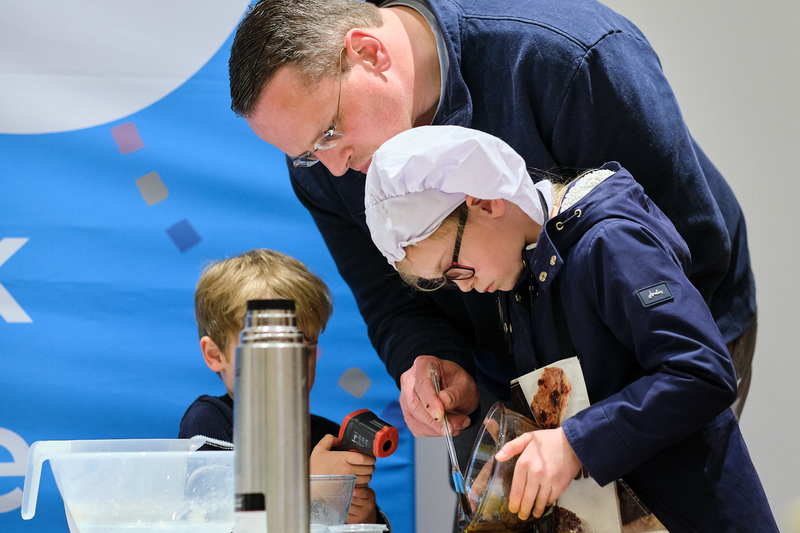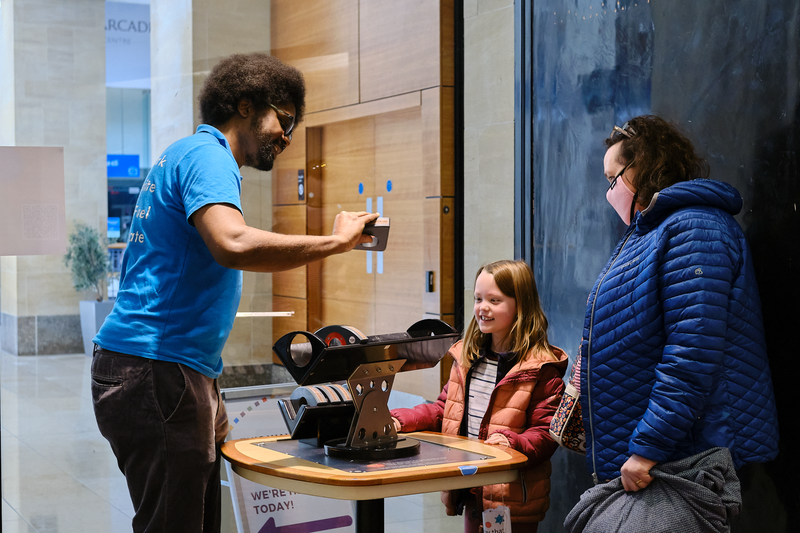Shaping the future of Cambridge Science Centre
Cambridge created a young person’s advisory panel, where young people input and guide the science centre’s work now and into the future.
Who did you work with?
- The Netherhall School - local, general-admission secondary school; our primary contact for this project was via the school geology/biology club, which was predominantly female.
- Cambridge Rare Disease Network (camRARE) – camRARE is a network of patients, advocates, and experts that work to improve treatment and support of the varied rare diseases that affect children and adults. We worked with the young people within the network who have a range of special educational needs and disabilities
- Young Trustees Movement – A network of young trustees, employers, and allies. We have engaged with them to help our board prepare for the addition of a young trustee(s)
- Queen Edith’s Community Forum – A local community group that has adult and young-person members. This group helped promote our work to recruit members to the forum
In addition, we worked with individuals who visited our Grand Arcade pop-up science centre.
Had you worked together before?
We have previously worked in The Netherhall School but this is was the first time that a co-creative-style dialogue has been opened with staff and students. We have also previously worked with camRARE, including working with them to deliver accessible sessions at our Centre and attendance at their conference. We have an on-going relationship with Queen Edith’s Community Forum, who are one of the community groups around Cambridge. We regularly attend their community events.
What priorities did you identify with your partner and how did this project meet the longer-term priorities of everyone involved?
Priorities communicated recognised the open nature of the forum to be a space to share ideas. Early discussions soon focused on and established the methods we could use to reach young people in their area. The design to have in-person, large-group meetings was clearly an issue, which was further evident once young people were signed up to the forum. Consequently, we worked with a decentralised model.
Correspondence with the Young Trustees Movement, focused on the group’s existing frameworks for procedures that needed to be put in place for the introduction of a Young Trustee, and how best to make any new young trustee feel inspired to come on board.
Summary of the project delivery aims
We aimed to create a young person’s advisory panel, where young people input and guide all areas of Cambridge Science Centre’s work now and into the future. We also prepared our Board of Trustees to plan for, recruit, and benefit from the recruitment of a young trustee.
How co-produced was your programme?
- Deciding together (encourages new and additional options, and joint decision making)
- Acting together (not only deciding what is best together, but forming a partnership to carry it out)

What steps did you take with your community partner in order to reach this level of co-production?
We began by reaching out to existing (adult) partners and sharing the aims and ambition of the They supported us by reaching out to young people in their area or providing us with other contacts that may be able to support us more effectively.
To create the panel from interested young people, we started by building trust via initial meetings to discuss the panel either in their space (e.g., the school club) or invitation to one of our space, inviting them to see our pop-up spaces and see a show or activity, and allowing them to ask any questions they wanted to learn more about us. The goal here was to ensure they understood Cambridge Science Centre (CSC) and its team, so that they understood on what they would be advising.
Trying to plan meetings and timings for the panel was where we really began to uncover the difficulties in getting young people this age (13-15) to meet all together, especially as some come from all different parts of the city – limitations of time and transport had major impacts on this. We reflected on this feedback, and our progress and options, and made the decision to decentralise the panel.
We also leveraged our partnership with the Grand Arcade Shopping Centre and used a space within our pop-up science centre to allow young people within the age-range of the panel to provide light-touch input on a set of questions. The goal was to have a wider ranges of “membership” options and, thus, diversity of input.
In regards to the Young Trustee, we established a connection with the Young Trustee Movement. We nominated one of our team to undergo the Young Trustee Champion training. This person is linked to a champion on our board of trustees, who is supporting our team member to contextualise information in a format suitable for the wider board.
Can you note down some of the benefits and challenges to working this way?
Working with community partners and external organisations has allowed us to reach a wider group of people, and allowed us to make new connections (for example, one of our contacts at a community group provided us with a connection to The Netherhall School – with whom we now have an ongoing relationship).
Key benefits have been able to use partner spaces, as well as CSC spaces, to allow us to meet members of the panel in-person but in a space both accessible and comfortable to those people. Common partner challenges have been faced, including identifying the most suitable staff/volunteer member to work with, and staff/volunteer turn-over impacting relationships. We were able to respond positively to these challenges, including via the decentralised model requiring less work from the staff/volunteers to manage transport, and by using the Grand Arcade to capture young people not known to our partners.
What was the STEM link?
We shared examples of our STEM-based products, which focus on knowledge and skills, as a way of illustrating to the panel members what and how we currently work. These sessions were also part of the trust and comfort building, as they provided an enjoyable and structured session to open communication. We did not focus on any specific area of STEM, often choosing topics that we felt represented current strengths of the Centre’s methods so that we could illicit feedback. We have also been learning from these young people by looking at what they consider to be STEM, as well as what they want to learn and what approaches work well for them. Thus, helping us to think about how we can communicate new topics and the routes that allow us to do this.

What happened?
During one of our early in-person discussions we were getting to know one of our panel members. At the beginning, they were quite shy and was reluctant to share their opinions. We spoke about what they like and doesn’t like at school, if science is a topic they enjoy, do they like visiting museums and centres? Across this they started to open up and be more willing to speak about their experiences. We learnt that chemistry is their favourite subject as it allows them to do fun experiments using equipment and materials you wouldn’t get to see or use every day. They also told us that they had previously visited spaces like ours, but that the timing to visit these locations doesn’t always work, and that they weren’t aware some of the places even existed - they had only recently become aware of Cambridge Science Centre themselves. They felt the places they had been before weren’t always suited to all ages, and that if there were more targeted age ranges (centre wide or in smaller sections), and spaces where they could feel it was suited to them, this would be good. Plus, it also emerged during our conversation that they really valued having the opportunity to see or take part in things you can’t do very easily normally, and that one way they really enjoyed learning at spaces like ours is to target as many of our senses as possible - are there things we can hear? Feel? Taste?
The key to this discussion was the posing of questions but, critically, the listening to and respecting of answers. By showing interest in the comments being made, the young person shared more and began to enjoy speaking to us. At this stage, we began to get deeper insights into how this person was thinking and feeling about STEM, CSC and science centres, and what they actually wanted to be able to visit, investigate, and impact.
What challenges might lie in wait for someone wanting to replicate this project
Building up a group of young people to take part in a panel such as this is a major (and on-going) challenge. There are many limiting factors along the way, including time commitments, ability to travel to meetings, location of meetings around the city and finding common times of availability amongst all group members. This also has to be balanced with our own staff time and availability. As such, time is a key element that must be provided because we do not always control the pace of progression, and we have to wait for progression from our partners and panel members.
Circumnavigating this to a degree was done by reaching out to young people via community groups and we had previously worked with, and through schools. Although, time is still needed as these partners will face the same logistical problems in bringing their groups
Were there any surprises?
The significance of the need to decentralise was a surprise. We expected complex logistics in bring people together, but not to the extent we faced. Decentralising (i.e., meeting sub-groups of the panel in-person, both allowed for better conversation and avoided the GDPR and safeguarding issues of online meetings. This challenge also inspired us to trial faster interactions with visitors to one of our pop-up spaces, with a feedback form. Although this was a short interaction and often an in-the-moment response to what had been experience immediately before, it provided some interesting ideas that could also be presented to the in-person groups to spark discussion.
How did you capture/measure the impact for this project?
We gathered feedback from in-person “interviews” and our team’s observations (reflective diaries). We used an in-house built Google Form for the Grand Arcade questionnaire.
The integration of a Young Trustee is still underway. However, by working with the Young Trustee Movement, we will be able to seek external viewpoints on progress we’ve made or yet to make, and how our organisation can be better prepared.
Where is the long-lasting change?
This project has long-lasting changes for CSC in both aspects of the project and will be on-going indefinitely. The inputs of the youth advisory panel are helping guide our plans for our pop-up programme and are being consulted on elements of our 5-year strategy. As an organisation for young people, we need to be guided in all aspects by young people – this guidance, and the resultant improvement in positive impact, is the legacy of this project. We are still working to improve the decentralised model, to incorporate a way to have meetings with all members, and to ensure information flows usefully between all sectors of the organisation and the panel. The changes to CSC, due to the panel have begun and will have a profound impact.
Did this project impact the future sustainability of your organisation?
By being guided by young people, CSC will be increasingly a young-person owned resource We will be a space for people to inspire their own learning. The impact this learning will have on lifetime STEM engagement is key to our charitable vision. Evidencing this, will allow us to bring in support from an array of partners to sustain our offering.
